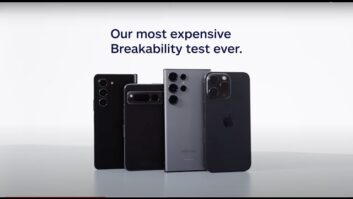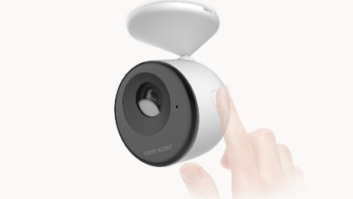NEW YORK –
Data-share plans will encourage consumers
to use more data, whether through tablets, mobile hot
spots, or dedicated USB modems, but will the new plans
from Verizon Wireless and AT&T stimulate sales of cellular-
equipped tablets?
Analysts are split.
To encourage subscribers to use more data, the shareddata
plans make it possible to add data devices such as
tablets to a subscription to use up previously unused data
bits from their smartphone’s bucket of bits. “We expect
these new plans will give us an opportunity to increase
overall wireless revenues over time,” an AT&T spokesperson
said. “The ability to add multiple devices on a single
plan gives customers an incentive to add additional devices
on the network. “
Though some analysts see the plans encouraging sales
of cellular-enabled tablets, other believe the plans might
simply encourage users to connect a Wi-Fi tablet to the
cellular network by tethering the tablet to a smartphone.
Tethering is included in the new shared-data plans at no
extra cost, whereas AT&T and Verizon previously charged
extra for the capability. Verizon, for example, charged $20
to activate a smartphone’s tethering capability.
The new plans also reduce another incentive to buy a
cellular-equipped tablet. The shared-data plans exclude
the option of buying a cellular-equipped tablet at a subsidized
price, both carriers said. That reduces the incentive
to buy a cellular-equipped tablet. In the case of the 16GB
Motorola Droid XYBoard 10.1, users received a $170 subsidy
with two-year contract when the tablet was launched.
That model launched at $529 with two-year contract and
$699 without, a spokesperson said. The Samsung Galaxy
Tab 7.7 was $499 with a two-year Verizon contract when it
launched in March, but the unsubsidized price was $699.
AT&T and Verizon have offered subsidies only for tablets
other than the iPad, and AT&T continues to do so
for consumers who don’t opt for a shared-data plan.
Verizon dropped tablet subsidies for all data plans at
the end of June.
Despite the loss of tablet subsidies under the shareddata
plans, some analysts expect the new plans to encourage
sales of cellular-equipped tablets, even if only
modestly.
“The shared data plans may provide a slight boost in the
number of cellular-capable tablets vs. Wi-Fi-only tablets,
but it will be a gradual transition,” contended John Weber,
associate research analyst at IDC. “Currently, many
consumers own consumer electronics, other than their
mobile phones, that are Wi-Fi-only. With Wi-Fi seemingly
available anywhere and mostly free in the United States,
consumers don’t necessarily see the need to have a 3Gor
4G-enabled tablet or laptop — or the need to buy into a
multi-device plan.”
For his part, Mark Lowenstein, principal of consulting
company M-Ecosystem, said he doesn’t believe the new
plans will boost sales of cellular-equipped tablets. “You
don’t have to pay full price for a separate data plan [for a
cellular-equipped tablet], but you do have to pay a monthly
recurring charge [$10] for the privilege of sharing in the
shared-data bucket. Most consumers only need cellular
connectivity for their tablets occasionally. I believe the majority
of consumers will forego the extra cost of the cellular-
equipped tablet and the $10 monthly charge and will
instead draft off the phone’s hot spot. The phone is always
with them anyway.”
IDC’s Weber is not so sure. “Tethering is a good option,
with a few limitations,” he said. “First, not all devices are
capable of tethering.” Another hindrance, he said, “is that
not all consumers are aware of tethering and how to enable
it, so it likely won’t be a major factor mitigating the use
of cellular-enabled tablets on shared data plans.”
Despite the free tethering option, CCS Insights of
the U.K. expects cellular-equipped tablet sales to rise
in the coming years in the U.S., although the company
expects the share of cellular-equipped tablets to fall because
of the growing prevalence of free Wi-Fi service.
“Share Everything will be very welcome among handset
manufacturers and is sure to provide a boost to sales
of cellular-enabled tablets,” CCS analyst Shaun Collins
told TWICE. “However, the growing prevalence of free
or bundled Wi-Fi access in the U.S. will still result in a
declining share of cellular-enabled variants in the market
going forward.”
“Ubiquitous Wi-Fi and significant difference in the retail
price of cellular and Wi-Fi tablets will drive more consumers
to Wi-Fi-only tablets, especially as consumer research
clearly shows that a large share of the tablet usage is at
home,” Collins said.
In North America, the company estimates that cellularenabled
tablets made up 53 percent of total tablet shipments
in 2011 but will slowly decrease to about 40 percent
in 2016. However, because the overall tablet market
will grow, in absolute terms the shipment of cellular-enabled
tablets will more than double from 2011 to 2016.
Shipments of Wi-Fi only tablets will grow even faster.
Whatever the tablet mix, analyst Jeff Kagan sees the
new plans raising sales of cellular-equipped tablets. “Yes I
do think these new data sharing plans will boost the sales
of cellular equipped tablets versus the Wi-Fi-only tablets,
but first customers have to get used to this new way of
billing, and that may take a little while.” One reason is that
the plans “don’t seem to save customers money, but they
really could if you take a closer
For her part, analyst Susan Welsh de Grimaldo of Strategy
Analytics sees gains for consumers and carriers no
matter how consumers connect their tablet to a carrier’s
network. For a tablet owner, including a 3G or 4G LTE tablet
in a shared-data plan for $10 a month, or using Wi-Fi
and the free tethering option on share data plans, “offers a
new value proposition to connecting their tablet for a relatively
low cost,” she told TWICE. And for carriers, either
option “could increase use of tablets on mobile networks
and encourage users to move up to a higher tier of data,
thus driving revenue,” she said.
In any case, shared-data plans will encourage people
who previously bought cellular-equipped tablets to actually
use the tablets’ cellular capabilities, she said. “In the
U.S., we have definitely seen a number of people purchase
a 3G- or 4G enabled tablet just in case they decided they
needed that option — and quite a few of them have never
signed up for mobile broadband service on their tablet.”
Strategy Analytics Mobile projects that tablets with active
mobile broadband subscriptions (whether prepaid or
postpaid) in the U.S. will grow from just more than 3 million
at end of 2011 to just more than 20 million by end of
2014, representing an increase in data-plan attach rates
from 20 percent to 30 percent from 2011 to 2014.













